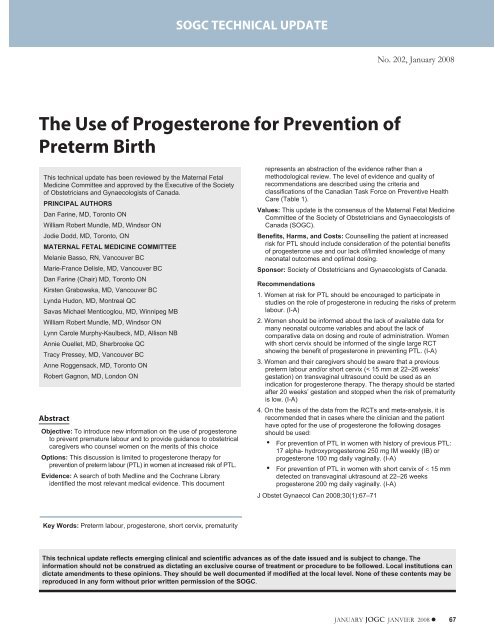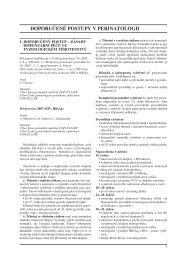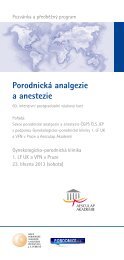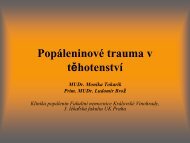The Use of Progesterone for Prevention of Preterm ... - ResearchGate
The Use of Progesterone for Prevention of Preterm ... - ResearchGate
The Use of Progesterone for Prevention of Preterm ... - ResearchGate
You also want an ePaper? Increase the reach of your titles
YUMPU automatically turns print PDFs into web optimized ePapers that Google loves.
SOGC TECHNICAL UPDATESOGC TECHNICAL UPDATENo. 202, January 2008<strong>The</strong> <strong>Use</strong> <strong>of</strong> <strong>Progesterone</strong> <strong>for</strong> <strong>Prevention</strong> <strong>of</strong><strong>Preterm</strong> BirthThis technical update has been reviewed by the Maternal FetalMedicine Committee and approved by the Executive <strong>of</strong> the Society<strong>of</strong> Obstetricians and Gynaecologists <strong>of</strong> Canada.PRINCIPAL AUTHORSDan Farine, MD, Toronto ONWilliam Robert Mundle, MD, Windsor ONJodie Dodd, MD, Toronto, ONMATERNAL FETAL MEDICINE COMMITTEEMelanie Basso, RN, Vancouver BCMarie-France Delisle, MD, Vancouver BCDan Farine (Chair) MD, Toronto ONKirsten Grabowska, MD, Vancouver BCLynda Hudon, MD, Montreal QCSavas Michael Menticoglou, MD, Winnipeg MBWilliam Robert Mundle, MD, Windsor ONLynn Carole Murphy-Kaulbeck, MD, Allison NBAnnie Ouellet, MD, Sherbrooke QCTracy Pressey, MD, Vancouver BCAnne Roggensack, MD, Toronto ONRobert Gagnon, MD, London ONAbstractObjective: To introduce new in<strong>for</strong>mation on the use <strong>of</strong> progesteroneto prevent premature labour and to provide guidance to obstetricalcaregivers who counsel women on the merits <strong>of</strong> this choiceOptions: This discussion is limited to progesterone therapy <strong>for</strong>prevention <strong>of</strong> preterm labour (PTL) in women at increased risk <strong>of</strong> PTL.Evidence: A search <strong>of</strong> both Medline and the Cochrane Libraryidentified the most relevant medical evidence. This documentrepresents an abstraction <strong>of</strong> the evidence rather than amethodological review. <strong>The</strong> level <strong>of</strong> evidence and quality <strong>of</strong>recommendations are described using the criteria andclassifications <strong>of</strong> the Canadian Task Force on Preventive HealthCare (Table 1).Values: This update is the consensus <strong>of</strong> the Maternal Fetal MedicineCommittee <strong>of</strong> the Society <strong>of</strong> Obstetricians and Gynaecologists <strong>of</strong>Canada (SOGC).Benefits, Harms, and Costs: Counselling the patient at increasedrisk <strong>for</strong> PTL should include consideration <strong>of</strong> the potential benefits<strong>of</strong> progesterone use and our lack <strong>of</strong>/limited knowledge <strong>of</strong> manyneonatal outcomes and optimal dosing.Sponsor: Society <strong>of</strong> Obstetricians and Gynaecologists <strong>of</strong> Canada.Recommendations1. Women at risk <strong>for</strong> PTL should be encouraged to participate instudies on the role <strong>of</strong> progesterone in reducing the risks <strong>of</strong> pretermlabour. (I-A)2. Women should be in<strong>for</strong>med about the lack <strong>of</strong> available data <strong>for</strong>many neonatal outcome variables and about the lack <strong>of</strong>comparative data on dosing and route <strong>of</strong> administration. Womenwith short cervix should be in<strong>for</strong>med <strong>of</strong> the single large RCTshowing the benefit <strong>of</strong> progesterone in preventing PTL. (I-A)3. Women and their caregivers should be aware that a previouspreterm labour and/or short cervix (< 15 mm at 22–26 weeks’gestation) on transvaginal ultrasound could be used as anindication <strong>for</strong> progesterone therapy. <strong>The</strong> therapy should be startedafter 20 weeks’ gestation and stopped when the risk <strong>of</strong> prematurityis low. (I-A)4. On the basis <strong>of</strong> the data from the RCTs and meta-analysis, it isrecommended that in cases where the clinician and the patienthave opted <strong>for</strong> the use <strong>of</strong> progesterone the following dosagesshould be used:• For prevention <strong>of</strong> PTL in women with history <strong>of</strong> previous PTL:17 alpha- hydroxyprogesterone 250 mg IM weekly (IB) orprogesterone 100 mg daily vaginally. (I-A)• For prevention <strong>of</strong> PTL in women with short cervix <strong>of</strong> 15 mmdetected on transvaginal uktrasound at 22–26 weeksprogesterone 200 mg daily vaginally. (I-A)J Obstet Gynaecol Can 2008;30(1):67–71Key Words: <strong>Preterm</strong> labour, progesterone, short cervix, prematurityThis technical update reflects emerging clinical and scientific advances as <strong>of</strong> the date issued and is subject to change. <strong>The</strong>in<strong>for</strong>mation should not be construed as dictating an exclusive course <strong>of</strong> treatment or procedure to be followed. Local institutions candictate amendments to these opinions. <strong>The</strong>y should be well documented if modified at the local level. None <strong>of</strong> these contents may bereproduced in any <strong>for</strong>m without prior written permission <strong>of</strong> the SOGC.JANUARY JOGC JANVIER 2008 67
SOGC TECHNICAL UPDATETable 1. Key to evidence statements and grading <strong>of</strong> recommendations, using the ranking <strong>of</strong> theCanadian Task Force on Preventive Health CareQuality <strong>of</strong> Evidence Assessment*I: Evidence obtained from at least one properly randomizedcontrolled trialII-1: Evidence from well-designed controlled trials withoutrandomizationII-2: Evidence from well-designed cohort (prospective orretrospective) or case-control studies, preferably from morethan one centre or research groupII-3: Evidence obtained from comparisons between times orplaces with or without the intervention. Dramatic results inuncontrolled experiments (such as the results <strong>of</strong> treatmentwith penicillin in the 1940s) could also be included in thiscategoryIII: Opinions <strong>of</strong> respected authorities, based on clinicalexperience, descriptive studies, or reports <strong>of</strong> expertcommitteesClassification <strong>of</strong> Recommendations†A. <strong>The</strong>re is good evidence to recommend the clinical preventiveactionB. <strong>The</strong>re is fair evidence to recommend the clinical preventiveactionC. <strong>The</strong> existing evidence is conflicting and does not allow tomake a recommendation <strong>for</strong> or against use <strong>of</strong> the clinicalpreventive action; however, other factors may influencedecision-makingD. <strong>The</strong>re is fair evidence to recommend against the clinicalpreventive actionE. <strong>The</strong>re is good evidence to recommend against the clinicalpreventive actionI. <strong>The</strong>re is insufficient evidence (in quantity or quality) to makea recommendation; however, other factors may influencedecision-making<strong>The</strong> quality <strong>of</strong> evidence reported in these guidelines has been adapted from <strong>The</strong> Evaluation <strong>of</strong> Evidence criteria described in the Canadian Task Forceon Preventive Health Care. 30†Recommendations included in these guidelines have been adapted from the Classification <strong>of</strong> Recommendations criteria described in the <strong>The</strong> CanadianTask Force on Preventive Health Care. 30INTRODUCTION<strong>Preterm</strong> birth remains a major clinical problem. Prevalencein Canada increased from 6.3% <strong>of</strong> live births in1981–1983 to 6.6% in 1991 and 7.6% in 2000, 1,2 although alarge portion <strong>of</strong> this increase is related to multiple pregnancies.<strong>The</strong>re are very few interventions that improve theprognosis <strong>of</strong> preterm labour. <strong>The</strong> use <strong>of</strong> antenatalcorticosteroids was shown consistently to have such aneffect, 3 but most studies on tocolysis, with the exception <strong>of</strong>one recent paper on nitroglycerin, 4 had very limited clinicaluse. Almost 50 years ago, Csapo et al. 5 promoted the progesteronesee-saw theory, which is that high progesteronelevels prevent uterine contractions and low levels facilitatesuch contractions. This is one reason <strong>for</strong> the use <strong>of</strong> progesteronetherapy in early pregnancy and the use <strong>of</strong> RU486, aprogesterone antagonist, to induce abortions. It seems thatthe hormonal control <strong>of</strong> contractions and labour in humansACOGCIPTLRCTRRABBREVIATIONSAmerican College <strong>of</strong> Obstetricians and Gynecologistsconfidence intervalpreterm labourrandomized controlled trialrelative riskis more complex than in other animals and that progesteronemay have a more limited role than in animal models. 6Recently several studies on the use <strong>of</strong> progesterone to preventpreterm labour have been published. <strong>The</strong> purpose <strong>of</strong>this paper is to evaluate the in<strong>for</strong>mation in these studies andoutline the current role <strong>for</strong> the use <strong>of</strong> progesterone <strong>for</strong> thisindication.DATA ON PROGESTERONE AND PRETERM LABOURMany studies have examined the use <strong>of</strong> progesterone <strong>for</strong>prevention <strong>of</strong> preterm labour. Mackenzie et al. 7 found 735such studies, but only three were appropriate <strong>for</strong> inclusionin their meta-analysis on therapy in the second trimester,which showed that the use <strong>of</strong> progestins in women at risk<strong>for</strong> preterm labour reduced its occurrence by 43% (RR 0.57[0.36–0.90]). Similar reduction <strong>of</strong> preterm births prior to 35weeks (33%) and 32 weeks (42%) was found. Two othermeta-analyses by Sanchez Ramos et al. 8 and Dodd et al. 9were completed recently. Dodd et al. concluded thatwomen who received progesterone were statistically significantlyless likely to give birth be<strong>for</strong>e 37 weeks (RR 0.58;95%CI0.48–0.70),tohaveaninfantwithbirthweight<strong>of</strong>> 2.5 kg (RR 0.62; 95% CI 0.49–0.78), or to have an infantdiagnosed with intraventricular hemorrhage (RR 0.25; 95%CI 0.08–0.82). <strong>The</strong>ir analysis showed no apparent benefit toearly start <strong>of</strong> the progesterone administration or in the use<strong>of</strong> higher doses. Sanchez-Ramos et al. selected 10 papers <strong>for</strong>68 JANUARY JOGC JANVIER 2008
<strong>The</strong> <strong>Use</strong> <strong>of</strong> <strong>Progesterone</strong> <strong>for</strong> <strong>Prevention</strong> <strong>of</strong> <strong>Preterm</strong> BirthTable 2. Study characteristics (adapted from Dodd et al. 9 )Authors/year N Agent Selection criteria Time (weeks)LeVine 1964 10 29 17P (500 mg/wk) SA 3 >16to36Papiernik 1970 11 97 17P (250 mg q.3d) High PTL score 28–32 8 dosesJohnson et al. 1975 12 43 17P (250 mg/wk) SA 2 or PTL < 36 wks Booking to 37Hauth et al. 1983 13 168 17P (1 g/wk) None 16–20 to 36Yemini et al. 1985 14 79 17P (250 mg/wk) SA 2 and/or PTL 2 Booking to 37da Fonseca et al. 2003 15 142 <strong>Progesterone</strong> (100 mg/d) PTL/cerclage/uterine 24–34anomalyMeis et al. 2003 16 463 17P (250 mg/wk) PTL 16–20 to 36Fonseca et al. 2007 17 250 <strong>Progesterone</strong> (200 mg/d) Cx < 15mm at 22–26 wks 24–34Rouse et al. 2007 18 661 17P (250 mg/wk) twins 16–20 to 36analysis, and their results were similar to those <strong>of</strong> the twoother meta-analyses. <strong>The</strong> characteristics <strong>of</strong> these studiesand more recent RCTs are outlined in Table 2.Reviews and meta-analysis on the topic published prior to2000 differed in methodology and inclusion criteria fromone another. None <strong>of</strong> them included the latest RCTsreviewed here. Daya et al. 19 looked at the use <strong>of</strong> progestinsto prevent losses in women who had recurrent losses.Kierse et al. 20 limited their analysis to therapy with 17alpha-hydroxyprogesterone, and the review by Goldsteinet al. 21 included studies on women at low risk <strong>for</strong> PTL. <strong>The</strong>studies by Daya et al. and Kierse et al. (but not the study byGoldstein et al.) showed some benefit in using progesterone.Other publications on cervical length changes and PTLare supportive. 22-24<strong>The</strong> main results <strong>of</strong> the RCTs outlined above are providedin Tables 3 and 4.SUMMARY OF THE CURRENTLY AVAILABLE DATA1. <strong>Prevention</strong> <strong>of</strong> PTL<strong>The</strong> summary <strong>of</strong> data presented above indicates that administration<strong>of</strong> progesterone in the second trimester to womenwith short cervix or with a previous history <strong>of</strong> pretermlabour may reduce their risk <strong>for</strong> preterm birth. This modifiesthe sole indication <strong>of</strong> PTL outlined in the ACOG technicalbulletin <strong>of</strong> 2003. 25 <strong>The</strong> ACOG guideline cautiouslyrecommends the use <strong>of</strong> progesterone exclusively in womenwith previous preterm labour.2. Frequency <strong>of</strong> <strong>Use</strong><strong>The</strong> frequency <strong>of</strong> progesterone use based on the ACOGrecommendations increased in the US from 38% in 2003 to67% in 2005. 26 In contrast, a recent Canadian study 27showed that only 7% <strong>of</strong> Canadian obstetricians were usingprogesterone <strong>for</strong> the prevention <strong>of</strong> PTL in 2004.3. Neonatal Outcome<strong>The</strong> use <strong>of</strong> progesterone contributes to a significant reductionin low birth weight and intraventricular hemorrhage.Further data are needed to demonstrate a significant reductionin the following outcomes: perinatal death, respiratorydistress syndrome, necrotizing enterocolitis, patent ductusarteriosus, sepsis, and retinopathy <strong>of</strong> prematurity, as thecurrent studies and the meta-analysis are underpowered todetect effect on these parameters.4. Safety<strong>Progesterone</strong> has been used extensively and safely in thefirst trimester, when the fetus is more vulnerable <strong>for</strong> lutealphase insufficiency and recurrent losses. To date, no datafrom RCTs and other studies <strong>for</strong> prevention <strong>of</strong> pretermbirth indicate this therapy is not safe aside from a singleretrospective study 28 that showed that the incidence <strong>of</strong> gestationaldiabetes was 12.9% in women treated with 17Pgroup (n = 557) compared with 4.9% in control subjects(n = 1524, P < 0.001; OR 2.9 [95% CI 2.1–4.1]).5. Route <strong>of</strong> Administration and Dosage<strong>The</strong>re are no data comparing routes <strong>of</strong> administration ordosing regimens. <strong>The</strong> meta-analysis <strong>of</strong> Dodd et al. 9 did notshow an added benefit <strong>of</strong> progesterone use prior to20 weeks’ gestation. A recent RCT reached the sameconclusions. 296. Need <strong>for</strong> Further Research<strong>The</strong>re are still large gaps in our knowledge. More data arerequired to properly evaluate the impact on neonatal outcomes.More in<strong>for</strong>mation is needed on <strong>for</strong>mulation (17alpha-hydroxyprogesterone vs. progesterone), route <strong>of</strong>administration (IM vs. vaginal or oral), and the optimal dosage<strong>for</strong> progesterone use. More research is required to providedefinitive data on the potential rare risks associatedJANUARY JOGC JANVIER 2008 69
SOGC TECHNICAL UPDATETable 3. Outcomes <strong>of</strong> studiesAuthors/year RR <strong>for</strong> PTL RR <strong>for</strong> B-weight < 2500 gm RR <strong>for</strong> perinatal mortalityLeVine 1964 10 0.61 (0.09–4.34) 1.62 (0.23–11.5) 3.21 (0.12–85.2)Papiernik 1970 11 0.18 (0.04–0.91) 0.21 (0.04–1.06) N/AJohnson et al. 1975 12 0.13 (0.03–0.72) 0.39 (0.10–1.51) 0.07 (0.03–1.32)Hauth et al. 1983 13 0.81 (0.27–2.45)Yemini et al. 1985 14 0.27 (0.09–0.85) 0.27 (0.09–0.85) N/Ada Fonseca et al. 2003 15 0.40 (0.17–0.94) N/AMeis et al. 2003 16 0.47 (0.31–0.69) 0.54 (0.36–0.81) 0.62 (0.27–1.40)Fonseca et al. 2007 17 0.56 (0.36–0.86) 0.96 (0.69–1.26) N/ARouse et al. 2007 18 1.1 (0.9–1.5) 0.9 (0.8–1.0) 1.4 (0.6 to 3.2)Table 4. Meta-analysis <strong>of</strong> neonatal clinical outcomes from six randomized trials thatcompared intramuscular progesterone with placeboOutcome Studies (n) Participants (n) Relative risk 95% CI<strong>Preterm</strong> birth (< 37 weeks) 6 878 0.59 (0.49–0.72)Birth weight <strong>of</strong> < 2.5 kg 6 872 0.62 (0.49–0.78)Perinatal death 6 876 0.60 (0.32–1.12)Stillbirth 1 459 1.50 (0.31–7.34)Neonatal death 1 459 0.44 (0.17–1.13)Respiratory distress syndrome 2 536 0.63 (0.38–1.05)Ventilatory support 1 454 0.59 (0.35–1.00)Intraventricular hemorrhage 1 458 0.25 (0.08–0.82)Necrotizing enterocolitis 1 457 Not estimablePatent ductus arteriosus 2 535 0.55 (0.22–1.36)Sepsis 2 536 0.96 (0.34–2.68)Retinopathy (prematurity) 1 457 0.50 (0.15–1.70)<strong>Use</strong>d with permission from Dodd et al. 9with progesterone administration. Currently, there is at leastone RCT (<strong>The</strong> PROGRESS study) recruiting Canadianpatients at risk <strong>for</strong> PTL to evaluate vaginal administration <strong>of</strong>progesterone <strong>for</strong> prevention <strong>of</strong> PTL.Recommendations1. Women at risk <strong>for</strong> PTL should be encouraged to participatein studies on the role <strong>of</strong> progesterone in reducingthe risks <strong>of</strong> preterm labour. (I-A)2. Women should be in<strong>for</strong>med about the lack <strong>of</strong> availabledata <strong>for</strong> many neonatal outcome variables and about thelack <strong>of</strong> comparative data on dosing and route <strong>of</strong> administration.Women with short cervix should be in<strong>for</strong>med <strong>of</strong>the single large RCT showing the benefit <strong>of</strong> progesteronein preventing PTL. (I-A)3. Women and their caregivers should be aware that aprevious spontaneous preterm labour and/or shortcervix (< 15 mm at 22–26 weeks’ gestation) ontransvaginal ultrasound could be used as an indication<strong>for</strong> prophylactic progesterone therapy. <strong>The</strong> therapyshould be started after 20 weeks’ gestation and stoppedwhen the risk <strong>of</strong> prematurity is low. (I-A)4. On the basis <strong>of</strong> the data from the RCTs and metaanalysis,it is recommended that in cases where the clinicianand the patient have opted <strong>for</strong> the use <strong>of</strong> progesteronethe following dosages should be used:• For prevention <strong>of</strong> PTL in women with history <strong>of</strong>previous PTL: 17 alpha-hydroxyprogesterone250 mg IM weekly (I-B) or progesterone 100 mgdaily vaginally. (I-A)• For prevention <strong>of</strong> PTL in women with short cervix<strong>of</strong> 15 mm detected on transvaginal ultrasound at22–26 weeks: progesterone 200 mg daily vaginally. (I-A)70 JANUARY JOGC JANVIER 2008
<strong>The</strong> <strong>Use</strong> <strong>of</strong> <strong>Progesterone</strong> <strong>for</strong> <strong>Prevention</strong> <strong>of</strong> <strong>Preterm</strong> BirthREFERENCES1. Joseph KS, Kramer MS, Marcoux S, Ohlsson A, Wen SW, Allen A, et al.Determinants <strong>of</strong> preterm birth rates in Canada from 1981 through 1983and from 1992 through 1994. N Engl J Med 1998;339:1434–9.2. Health Canada. Canadian Perinatal Surveillance System. Canadian PerinatalHealth Report 2003. Chapter 4;73–6. Available at:http://www.phac-aspc.gc.ca/rhs-ssg/phic-ispc/index.html. AccessedAugust 10, 2007.3. Crane J, Armson A, Brunner M, De La Ronde S, Farine D, Keenan-LindsayL, et al. Antenatal corticosteroid therapy <strong>for</strong> fetal maturation. SOGCClinical Practice Guideline No. 122, January 2003. J Obstet Gynaecol Can2003;25(1):45–52.4. Smith GN, Walker MC, Ohlsson A, O’Brien K, Windrim R. Canadian<strong>Preterm</strong> Labour Nitroglycerin Trial Group. Randomized double-blindplacebo-controlled trial <strong>of</strong> transdermal nitroglycerin <strong>for</strong> preterm labor.Am J Obstet Gynecol 2005;196(1):37.e1–8.5. Csapo AI. <strong>Progesterone</strong> “block.” Am J Anat 1956;98:273–92.6. Norwitz ER, Robinson JN, Challis JR. <strong>The</strong> control <strong>of</strong> labor. N Engl J Med1999; 341(9):660–6.7. Mackenzie R, Walker M, Armson, A, Hannah, ME. <strong>Progesterone</strong> <strong>for</strong> theprevention <strong>of</strong> preterm birth among women at increased risk: a systematicreview and meta-analysis <strong>of</strong> randomized controlled trials. Am J ObstetGynecol 2006;194(5):1234–42.8. Sanchez-Ramos L, Kaunitz AM, Delke I. Progestational agents to preventpreterm birth: a meta-analysis <strong>of</strong> randomized controlled trials. ObstetGynecol 2005;105:273–9.9. Dodd JM, Flenady V, Cincotta R, Crowther CA. Prenatal administration <strong>of</strong>progesterone <strong>for</strong> preventing preterm birth. Cochrane Database Syst Rev2006;1:CD004947.10. LeVine L. Habitual abortion: a controlled study <strong>of</strong> progestational therapy.West J Surg Obstet Gynecol 1964;72:30–6.11. Papiernik E. Double blind study <strong>of</strong> an agent to prevent preterm deliveryamong women at increased risk [in French]. Edition Schering, Serie IV,fiche 3, 1970:65–8.12. Johnson JW, Austin KL, Jones GS, Davis GH, King TM. Efficacy <strong>of</strong>17alpha-hydroxyprogesterone caproate in the prevention <strong>of</strong> prematurelabor. N Engl J Med 1975;293:675–80.13. Hauth JC, Gilstrap LC, Brekken AL, Hauth JM. <strong>The</strong> effect <strong>of</strong> 17 alphahydroxyprogesterone caproate on pregnancy outcome in an active-dutymilitary population. Am J Obstet Gynecol 1983;146:187–90.14. Yemini M, Borenstein R, Dreazen E, Apelman Z, Mogilner BM, Kessler I,et al. <strong>Prevention</strong> <strong>of</strong> premature labor by 17a-hydroxyprogesterone caproate.Am J Obstet Gynecol 1985;151:574–7.15. da Fonseca EB, Bittar RE, Carvalho MH, Zugaib M. Prophylacticadministration <strong>of</strong> progesterone by vaginal suppository to reduce theincidence <strong>of</strong> spontaneous preterm birth in women at increased risk: arandomized placebo-controlled double-blind study. Am J Obstet Gynecol2003;188:419–24.16. Meis PJ, Kleban<strong>of</strong>f M, Thom E, Mitchell P. <strong>Prevention</strong> <strong>of</strong> recurrent pretermdelivery by 17-alpha hydroxyprogesterone caproate. N Engl J Med2003;348:2379–85.17. Fonseca EB, Celik E, Parra M, Singh M, Nicolaides KH. <strong>Progesterone</strong> andthe risk <strong>of</strong> preterm birth among women with a short cervix. N Engl J Med2007;357:462–9.18. Rouse DJ, Caritis SN, Peaceman AM, Sciscione A, Thom EA, Spong CY,et al. A trial <strong>of</strong> 17 alpha-hydroxyprogesterone caproate to preventprematurity in twins. N Engl J Med 2007;357(5):454–61.19. Daya S. Efficacy <strong>of</strong> progesterone support <strong>for</strong> pregnancy in women withrecurrent miscarriage: a meta-analysis <strong>of</strong> controlled trials. Br J ObstetGynaecol 1989;96:275–80.20. Kierse MJNC. Progestogen administration in pregnancy may preventpreterm delivery. Br J Obstet Gynaecol 1990;97:149–54.21. Goldstein P, Berrier J, Rosen S, Sacks HS, Chalmers TC. A metaanalysis <strong>of</strong>randomized control trials <strong>of</strong> progestational agents in pregnancy. Br J ObstetGynaecol 1989;96:265–74.22. Facchinetti F, Paganelli S, Comitini G, Dante G, Volpe A. Cervical lengthchanges during preterm cervical ripening: effects <strong>of</strong>17-hydroxyprogesterone caproate. Am J Obstet Gynecol2007;196:453.e1-453.e4.23. Iams JD, Goldenberg RL, Meis PJ, Mercer BM, Moawad A, Das A, et al.<strong>The</strong> length <strong>of</strong> the cervix and the risk <strong>of</strong> spontaneous premature delivery.N Engl J Med 1996;334:567–72.24. Berghella V, Odibo AO, To MS, Rust OA, Althuisius SM. Cerclage <strong>for</strong>short cervix on ultrasonography: meta-analysis <strong>of</strong> trials using individualpatient-level data. Obstet Gynecol 2005;106(1):181–926.25. ACOG Committee Opinion. <strong>Use</strong> <strong>of</strong> progesterone to reduce preterm birth.Obstet Gynecol 2003;102:1115–6.26. Ness A, Dias T, Damus K, Burd I, Berghella V. Impact <strong>of</strong> the recentrandomized trials on the use <strong>of</strong> progesterone to prevent preterm birth:a 2005 follow-up survey. Am J Obstet Gynecol 2006;195(4):1174–9.27. Hui D, Liu G, Kavuma E, Hewson SA, McKay D, Hannah ME. <strong>Preterm</strong>labour and birth: a survey <strong>of</strong> clinical practice regarding use <strong>of</strong> tocolytics,antenatal corticosteroids, and progesterone. J Obstet Gynaecol Can2007;29(2):117–30.28. Rebarber A. Istwan NB. Russo-Stieglitz K. Cleary-Goldman J. Rhea DJ.Stanziano GJ. Saltzman DH. Increased incidence <strong>of</strong> gestational diabetes inwomen receiving prophylactic 17alpha-hydroxyprogesterone caproate <strong>for</strong>prevention <strong>of</strong> recurrent preterm delivery. Diabetes Care. 30(9):2277–80,2007 Sep.29. How HY, Barton JR, Istwan NB, et al. Prophylaxis with 17alpha-hydroxyprogesterone caproate <strong>for</strong> prevention <strong>of</strong> recurrent pretermdelivery: does gestational age at initiation <strong>of</strong> treatment matter? Am J ObstetGynecol 2007;197:260.e1–260.e4.30. Woolf SH, Battista RN, Anderson GM, Logan AG, Eel W. Canadian Task<strong>for</strong>ce on Preventive Health Care. New grades <strong>for</strong> receommendations fromthe Canadian Task <strong>for</strong>ce on Preventive Health Care. CMAJ2003;169(3):207–8.JANUARY JOGC JANVIER 2008 71









